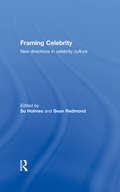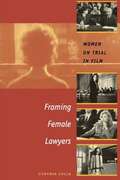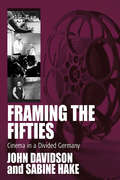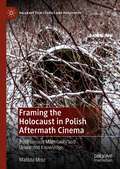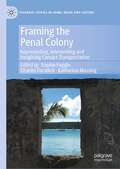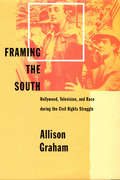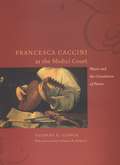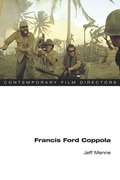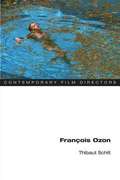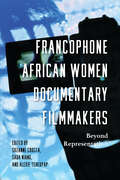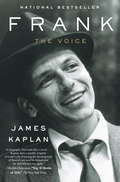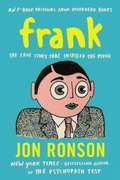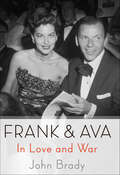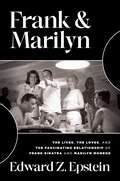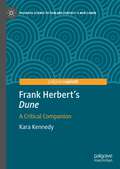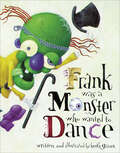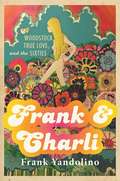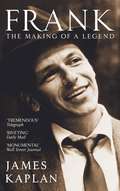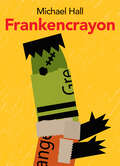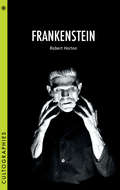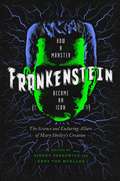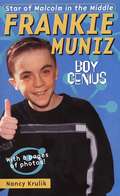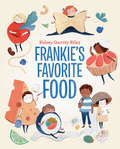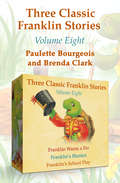- Table View
- List View
Framing Celebrity: New directions in celebrity culture
by Sean Redmond Su HolmesCelebrity culture has a pervasive presence in our everyday lives – perhaps more so than ever before. It shapes not simply the production and consumption of media content but also the social values through which we experience the world. This collection analyses this phenomenon, bringing together essays which explore celebrity across a range of media, cultural and political contexts. The authors investigate topics such as the intimacy of fame, political celebrity, stardom in American ‘quality’ television (Sarah Jessica Parker), celebrity 'reality' TV (I’m a Celebrity … Get Me Out of Here!), the circulation of the porn star, the gallery film (David/David Beckham), the concept of cartoon celebrity (The Simpsons), fandom and celebrity (k.d. lang, *NSYNC), celebrity in the tabloid press, celebrity magazines (heat, Celebrity Skins), the fame of the serial killer and narratives of mental illness in celebrity culture. The collection is organized into four themed sections: Fame Now broadly examines the contemporary contours of fame as they course through new media sites (such as 'reality' TV and the internet) and different social, cultural and political spaces. Fame Body attempts to situate the star or celebrity body at the centre of the production, circulation and consumption of contemporary fame. Fame Simulation considers the increasingly strained relationship between celebrity and artifice and ‘authenticity’. Fame Damage looks at the way the representation of fame is bound up with auto-destructive tendencies or dissolution.
Framing Female Lawyers: Women on Trial in Film
by Cynthia LuciaAs real women increasingly entered the professions from the 1970s onward, their cinematic counterparts followed suit. Women lawyers, in particular, were the protagonists of many Hollywood films of the Reagan-Bush era, serving as a kind of shorthand reference any time a script needed a powerful career woman. Yet a close viewing of these films reveals contradictions and anxieties that belie the films' apparent acceptance of women's professional roles. In film after film, the woman lawyer herself effectively ends up "on trial" for violating norms of femininity and patriarchal authority.<P><P>In this book, Cynthia Lucia offers a sustained analysis of women lawyer films as a genre and as a site where other genres including film noir, maternal melodrama, thrillers, action romance, and romantic comedy intersect. She traces Hollywood representations of female lawyers through close readings of films from the 1949 Adam's Rib through films of the 1980s and 1990s, including Jagged Edge, The Accused, and The Client, among others. She also examines several key male lawyer films and two independent films, Lizzie Borden's Love Crimes and Susan Streitfeld's Female Perversions. Lucia convincingly demonstrates that making movies about women lawyers and the law provides unusually fertile ground for exploring patriarchy in crisis. This, she argues, is the cultural stimulus that prompts filmmakers to create stories about powerful women that simultaneously question and undermine women's right to wield authority.
Framing The Fifties
by Sabine Hake John DavidsonThe demise of the New German Cinema and the return of popular cinema since the 1990s have led to a renewed interest in the postwar years and the complicated relationship between East and West German cinema in particular. A survey of the 1950s, as offered here for the first time, is therefore long overdue. Moving beyond the contempt for "Papa's Kino" and the nostalgia for the fifties found in much of the existing literature, this anthology explores new uncharted territories, traces hidden connections, discovers unknown treasures, and challenges conventional interpretations. Informed by cultural studies, gender studies, and the study of popular cinema, this anthology offers a more complete account by focusing on popular genres, famous stars, and dominant practices, by taking into account the complicated relationships between East vs. West German, German vs. European, and European vs. American cinemas; and by paying close attention to the economic and political conditions of film production and reception during this little-known period of German film history.
Framing the Holocaust in Polish Aftermath Cinema: Posthumous Materiality and Unwanted Knowledge (Palgrave Film Studies and Philosophy)
by Matilda MrozThis book offers a unique perspective on contemporary Polish cinema’s engagement with histories of Polish violence against their Jewish neighbours during the Holocaust. Moving beyond conventional studies of historical representation on screen, the book considers how cinema reframes the unwanted knowledge of violence in its aftermaths. The book draws on Derridean hauntology, Didi-Huberman’s confrontations with art images, Levinasian ethics and anamorphosis to examine cinematic reconfigurations of histories and memories that are vulnerable to evasion and formlessness. Innovative analyses of Birthplace (Łoziński, 1992), It Looks Pretty From a Distance (Sasnal, 2011), Aftermath (Pasikowski, 2012), and Ida (Pawlikowski, 2013) explore how their rural filmic landscapes are predicated on the radical exclusion of Jewish neighbours, prompting archaeological processes of exhumation. Arguing that the distressing materiality of decomposition disturbs cinematic composition, the book examines how Poland’s aftermath cinema attempts to recompose itself through form and narrative as it faces Polish complicity in Jewish death.
Framing the Penal Colony: Representing, Interpreting and Imagining Convict Transportation (Palgrave Studies in Crime, Media and Culture)
by Charles Forsdick Sophie Fuggle Katharina MassingThis book examines the representation of penal colonies both historically and in contemporary culture, across an array of media. Exploring a range of geographies and historical instances of the penal colony, it seeks to identify how the ‘penal colony’ as a widespread phenomenon is as much ‘imagined’ and creatively instrumentalized as it pertains to real sites and populations. It concentrates on the range of ‘media’ produced in and around penal colonies both during their operation and following their closures. This approach emphasizes the role of cross-disciplinary methods and approaches to examining the history and legacy of convict transportation, prison islands and other sites of exile. It develops a range of methodological tools for engaging with cultures and representations of incarceration, detention and transportation. The chapters draw on media discourse analysis, critical cartography, museum and heritage studies, ethnography, architectural history, visual culture including film and comics studies and gaming studies. It aims to disrupt the idea of adopting linear histories or isolated geographies in order to understand the impact and legacy of penal colonies. The overall claim made by the collection is that understanding the cultural production associated with this global phenomenon is a necessary part of a wider examination of carceral imaginaries or ‘penal spectatorship’ (Brown, 2009) past, present and future. It brings together historiography, criminology, media and cultural studies.
Framing the South: Hollywood, Television, and Race during the Civil Rights Struggle
by Allison GrahamWhat patterns emerge in media coverage and character depiction of Southern men and women, blacks and whites, in the years between 1954 and 1976? How do portrayals of the region and the equal rights movement illuminate the spirit and experience of the South—and of the nation as a whole? In Framing the South, Allison Graham examines the ways in which the media, particularly television and film, presented Southerners during the period of the civil rights revolution.Graham analyzes depictions of southern race and social class in a wide range of Hollywood films—including A Streetcar Named Desire, The Three Faces of Eve, and A Face in the Crowd from the 1950s; later films like Cool Hand Luke, In the Heat of the Night, and Mississippi Burning; and MGM's Elvis Presley vehicles. She traces how films have confronted—or avoided—issues of racism over the years, paralleling Hollywood depictions with the tamer characterization of the likeable "hillbilly" popularized in television's The Real McCoys and The Andy Griffith Show. Graham reinforces the political impact of these fictional representations by examining media coverage of civil rights demonstrations, including the documentary Crisis: Behind the Presidential Commitment, which reported the clash between Robert Kennedy and Governor George Wallace over the integration of the University of Alabama. She concludes with a provocative analysis of Forrest Gump, identifying the popular film as a retelling of post-World War II Southern history.
Francesca Caccini at the Medici Court
by Catharine R. Stimpson Suzanne G. CusickA contemporary of Shakespeare and Monteverdi, and a colleague of Galileo and Artemisia Gentileschi at the Medici court, Francesca Caccini was a dominant musical figure there for thirty years. Dazzling listeners with the transformative power of her performances and the sparkling wit of the music she composed for more than a dozen court theatricals, Caccini is best remembered today as the first woman to have composed opera. Francesca Caccini at the Medici Court reveals for the first time how this multitalented composer established a fully professional musical career at a time when virtually no other women were able to achieve comparable success. Suzanne G. Cusick argues that Caccini's career depended on the usefulness of her talents to the political agenda of Grand Duchess Christine de Lorraine, Tuscany's de facto regent from 1606 to 1636. Drawing on Classical and feminist theory, Cusick shows how the music Caccini made for the Medici court sustained the culture that enabled Christine's power, thereby also supporting the sexual and political aims of its women. In bringing Caccini's surprising story so vividly to life, Cusick ultimately illuminates how music making functioned in early modern Italy as a significant medium for the circulation of power.
Francis Ford Coppola (Contemporary Film Directors)
by Jeff MenneAcclaimed as one of the most influential and innovative American directors, Francis Ford Coppola is also lionized as a maverick auteur at war with Hollywood's power structure and an ardent critic of the postindustrial corporate America it reflects. However, Jeff Menne argues that Coppola exemplifies the new breed of creative corporate person and sees the director's oeuvre as vital for reimagining the corporation in the transformation of Hollywood. Reading auteur theory as the new American business theory, Menne reveals how Coppola's vision of a new kind of company has transformed the worker into a liberated and well-utilized artist, but has also commodified individual creativity at a level unprecedented in corporate history. Coppola negotiated the contradictory roles of shrewd businessman and creative artist by recognizing the two roles are fused in a postindustrial economy. Analyzing films like The Godfather (1970) and the overlooked Tucker: The Man and His Dream (1988) through Coppola's use of opera, Menne illustrates how Coppola developed a defining musical aesthetic while making films that reflected the idea of a corporation as family--and how his studio American Zoetrope came to represent a new brand of auteurism and the model for post-Fordist Hollywood.
Francois Ozon (Contemporary Film Directors)
by Thibaut SchiltIn just over a decade, François Ozon has earned an international reputation as a successful and provocative filmmaker. A student of Eric Rohmer and Jean Douchet at the prestigious Fémis, Ozon made a number of critically acclaimed shorts in the 1990s and released his first feature film Sitcom in 1998. Two additional shorts and eleven feature films have followed, including international successes 8 femmes and Swimming Pool and more recent releases such as Angel, Ricky, and Le refuge. Ozon's originality lies in his filmmaking style, which draws on familiar cinematic traditions (the crime thriller, the musical, the psychological drama, the comedy, the period piece) but simultaneously mixes these recognizable genres and renders them unfamiliar. Despite tremendous diversity in cinematic choices, Ozon's oeuvre is surprisingly consistent in its desire to blur the traditional frontiers between the masculine and the feminine, gay and straight, reality and fantasy, auteur and commercial cinema. Thibaut Schilt provides an overview of François Ozon's career to date, highlighting the director's unrestrained, voracious cinephilia, his recurrent collaborations with women screenwriters and actresses, and the trademarks of his cinema including music, dance, and the clothes that accompany these now typically Ozonian episodes. Schilt contextualizes Ozon's filmmaking within the larger fields of French filmmaking and international queer cinema, and he discusses several major themes running through Ozon's work, including obsessions with inadequate fathers, various types of mourning, and a recurring taste for "the foreign." The volume also includes an insightful interview with the director.
Francophone African Women Documentary Filmmakers: Beyond Representation (Studies in the Cinema of the Black Diaspora)
by Florence Martin Melissa Thackway Sheila Petty El Hadji Diop Felix Veilleux Suzanne Gauch Herve TchumkamFrancophone African Women Documentary Filmmakers is groundbreaking edited collection which explores the contributions of Francophone African women to the field of documentary filmmaking. Rich in its scope and critical vision it constitutes a timely contribution to cutting-edge scholarly debates on African cinemas. Featuring 10 chapters from prominent film scholars, it explores the distinctive documentary work and contributions of Francophone African women filmmakers since the 1960s. It focuses documentaries by North African and Sub-Saharan women filmmakers, including the pioneering work of Safi Faye in Kaddu Beykat, Rama Thiaw's The Revolution Will Not be Televised, Katy Lena Ndiaye's Le Cercle des noyes and En attendant les hommes, Dalila Ennadre's Fama: Heroism Without Glory and Leila Kitani's Nos lieux interdits. Shunned from costly fictional- 35mm-filmmaking, Francophone African Women Documentary Filmmakers examines how these women engaged and experimented with documentary filmmaking in personal, evocative ways that countered the officially sanctioned, nationalist practice of show and teach/promote.
Frank
by James KaplanBestselling author James Kaplan redefines Frank Sinatra in a triumphant new biography that includes many rarely seen photographs. Frank Sinatra was the best-known entertainer of the twentieth century--infinitely charismatic, lionized and notorious in equal measure. But despite his mammoth fame, Sinatra the man has remained an enigma. As Bob Spitz did with the Beatles, Tina Brown for Diana, and Peter Guralnick for Elvis, James Kaplan goes behind the legend and hype to bring alive a force that changed popular culture in fundamental ways. Sinatra endowed the songs he sang with the explosive conflict of his own personality. He also made the very act of listening to pop music a more personal experience than it had ever been. In Frank: The Voice, Kaplan reveals how he did it, bringing deeper insight than ever before to the complex psyche and turbulent life behind that incomparable vocal instrument. We relive the years 1915 to 1954 in glistening detail, experiencing as if for the first time Sinatra's journey from the streets of Hoboken, his fall from the apex of celebrity, and his Oscar-winning return in From Here to Eternity. Here at last is the biographer who makes the reader feel what it was really like to be Frank Sinatra--as man, as musician, as tortured genius.From the Hardcover edition.
Frank
by Jon RonsonFrom the bestselling author of The Psychopath Test comes a characteristically humorous story of a musician on the margins. In Frank: The True Story that Inspired the Movie, Jon Ronson reflects on his days playing keyboard for the Frank Sidebottom Oh Blimey Big Band. Frank Sidebottom, best known for performing with a big fake head with a cartoon face painted on it, was a cult favorite in the United Kingdom and is the subject of the new movie Frank, co-written by Ronson and starring Michael Fassbender, Maggie Gyllenhaal, and Domhnall Gleeson.
Frank & Ava: In Love and War
by John Brady"If I had to go back in Hollywood history and name two people who were most desperately and passionately in love with each other, I would say Frank Sinatra and Ava Gardner were It" —Liz SmithIt began in Hollywood's golden age when Ava was emerging as a movie star. But she fell in (and out of) love too easily. Mickey Rooney married her because he wanted another conquest. Artie Shaw treated her like a dumb brunette, giving her a reading list on their honeymoon. Neither marriage lasted a year. Then, after being courted by Howard Hughes and numerous others, along came Frank Sinatra.His passion for Ava destroyed his marriage and brought him close to ruin. Their wild affair broke all the rules of the prudish era as Frank left his wife and children and pursued Ava on an international stage. They became romantic renegades, with the press following them from location to location."Oh, God, Frank Sinatra could be the sweetest, most charming man in the world when he was in the mood," said Ava. They married, but then came the quarrels, separations, infidelities, and reconciliations. Eventually, there was a divorce, and they thought it was over. It wasn't.Through all of the tortured years of separation and splintered affairs with others, they maintained a secretive relationship known only to those who recognized that this was the love of a lifetime. Over the years they attempted to reconcile, romanced and nurtured each other, right to the end.The love story of Frank and Ava has never been fully explored or explained - until now. John Brady's Frank & Ava delves deeply into the lives of these two iconic stars and their turbulent lifelong relationship. More than anything else, this is the story of a romance lived out under battlefield conditions.
Frank & Marilyn: The Lives, the Loves, and the Fascinating Relationship of Frank Sinatra and Marilyn Monroe
by Edward Z. EpsteinFrank Sinatra! Marilyn Monroe! Never before teamed in a book, yet theirs was a seven-year friendship and on-and-off intimate relationship shrouded in secrecy and fraught with danger.Frank Sinatra and Marilyn Monroe—here is the first book to bring these two all-American icons together. Their friendship and on-and-off intimate relationship, kept secret because of powerful others in their lives, spanned seven tumultuous years. At one point, he even proposed marriage. In Frank & Marilyn, we follow Sinatra and Monroe from one explosive relationship to another, their marriages and love affairs eventually leading to a tangled relationship with each other, sparking a nasty rivalry between Frank and Marilyn&’s ex-husband (and one-time friend of Frank), Joe DiMaggio. Frank and Marilyn&’s ultimately disastrous relationship with John F. Kennedy, his brother Robert, and their often ruthless family was a fatal move for Marilyn. Her death remains a controversial topic to the present day. Dedicated biographer and entertainment world insider Edward Z. Epstein has spoken with many people who were familiar with the pair, all of whom talked about the Frank and Marilyn they knew—and the dangers they faced. It&’s a fascinating, largely untold story that&’s usually glossed over…until now.
Frank Herbert's "Dune": A Critical Companion (Palgrave Science Fiction and Fantasy: A New Canon)
by Kara KennedyThis book offers a critical study of Frank Herbert’s Dune (1965), the world’s bestselling science fiction novel. Kara Kennedy discusses the novel’s exploration of politics and religion, its influential ecological messages, the focus on the human mind and consciousness, the complex nature of the archetypal hero, and the depiction of women’s influence and control. In Dune, Herbert demonstrated that sophistication, complexity, and a multi-layered world with three-dimensional characters could sit comfortably within the science fiction genre. Underneath its deceptively simple storyline sits a wealth of historical and philosophical contexts and influences that make it a rich masterpiece open to multiple interpretations. Kennedy’s study shows the continuing relevance of the novel in the 21st century due to its classic themes and its concerns about the future of humanity, as well as the ongoing nature of issues such as ecological disruption and conflicts over resources and religion.
Frank Was a Monster Who Wanted to Dance
by Keith GravesFrank was a monster who wanted to dance. So he put on his hat, and his shoes made in France... and opened a jar and put ants in his pants! So begins this monstrously funny, deliciously disgusting, horrifyingly hilarious story of a monster who follows his dream. Keith Graves' wacky illustrations and laugh-out-loud text will tickle the funny bone and leave readers clamoring for an encore.
Frank and Charli: Woodstock, True Love, and the Sixties
by Frank YandolinoStories of Remarkable People and Enduring Love in the Time of Woodstock In the 1960s and '70s, Frank Yandolino rode the hippie counterculture movement alongside visionaries like Artie Kornfeld and Michael Lang, and he helped put together the Woodstock Festival of 1969, the era’s emblem of love and peace. From then on (and even before that), Yandolino, a beguiling fast-talker, charmer, and gifted storyteller, took charge of his life according to those ideals, grabbing and embracing all opportunities that were thrown his way. This memoir is an account of his life as a hippie, art director, entrepreneur, manager, and screenwriter (as well as various other hats he wore in the creative industry)—representing musicians like Joe Cocker and Paul Butterfield, art directing at Penthouse magazine, designing "erotic sheets,” writing a screenplay about Marilyn Monroe and her seamstress Lena Pepitone, among other things. With his gung-ho attitude and fortuitous connections, Yandolino befriended Salvador Dali, hung out with Jimi Hendrix, ran with Abbie Hoffman, was kidnapped by a festival security detail in Paris, mixed with models and Penthouse pets, and watched secret Hells Angels initiation ceremonies. Throughout it all, Yandolino’s key message is his "free bird” philosophy of grabbing every chance you can and staying true to one’s artistic individuality. And, in the end, despite his fast life, he was always grounded by his love for his wife, Charli.
Frank: The Making of a Legend
by James Kaplan'At last, Sinatra has the biography he deserves' - The Irish TimesFrank Sinatra was the best-known entertainer of his century - infinitely charismatic, more legendary and notorious than any other public personality of his era. But no matter what you think, you don't know him.In this critically acclaimed biography, James Kaplan reveals how Sinatra made listening to pop music a more personal experience than it had ever been. We relive the years 1915 to 1954 in vibrant detail, experiencing as if for the first time Sinatra's journey from the streets of Hoboken, his fall from the summit of celebrity, and his Oscar-winning return in From Here to Eternity. Here is the book that, finally, gets under his skin.
Frankencrayon
by Michael HallIngenuity and surprise rule in this funny and colorful companion to Red: A Crayon’s Story written and illustrated by Michael Hall, the New York Times–bestselling creator of My Heart Is Like a Zoo.The crayons are ready to tell the thrilling tale of Frankencrayon. The costumes are made, the roles are cast, the pages are all set—but then disaster strikes. Someone has scribbled on the page! Hideous! Horrifying! The story can’t go on! Try as they might, the crayons can’t erase the scribble, and this picture book must be canceled. Until the crayons playing the title role of Frankencrayon think of a solution, that is. Michael Hall breaks borders and invites readers behind the scenes with his irresistible, clever style and bold artwork. A book about seeing beauty in unexpected places and the magic of storytelling.
Frankenstein
by Robert HortonJames Whale's Frankenstein (1931) spawned a phenomenon that has been rooted in world culture for decades. This cinematic Prometheus has generated countless sequels, remakes, rip-offs, and parodies in every media, and this granddaddy of cult movies constantly renews its followers in each generation. Along with an in-depth critical reading of the original 1931 film, this book tracks Frankenstein the monster's heavy cultural tread from Mary Shelley's source novel to today's Internet chat rooms.
Frankenstein (Cultographies)
by Robert HortonJames Whale's Frankenstein (1931) spawned a phenomenon that has been rooted in world culture for decades. This cinematic Prometheus has generated countless sequels, remakes, rip-offs, and parodies in every media, and this granddaddy of cult movies constantly renews its followers in each generation. Along with an in-depth critical reading of the original 1931 film, this book tracks Frankenstein the monster's heavy cultural tread from Mary Shelley's source novel to today's Internet chat rooms.
Frankenstein: How A Monster Became An Icon: The Science And Enduring Allure Of Mary Shelley's Creation
by Sidney Perkowitz Eddy Von MuellerFew creations have risen from literary origins to reach world-wide importance like Frankenstein. This landmark volume celebrates the bicentenary of Mary Shelley's creation and its indelible impact on art and culture. The tale of a tormented creature created in a laboratory began on a rainy night in 1816 in the imagination of a nineteen-year-old Mary Wollstonecraft Shelley, newly married to the celebrated Romantic poet Percy Shelley. Since its publication two years later, in 1818, Frankenstein: Or, the Modern Prometheus has spread around the globe through every possible medium and variation. Frankenstein has not been out of print once in 200 years. It has appeared in hundreds of editions, perhaps more than any other novel. It has inspired a multitude of stage and screen adaptations, the latest appearing just last year. “Frankenstein” has become an indelible part of popular culture, and is shorthand for anything bizarre and human-made; for instance, genetically modified crops are “Frankenfood.” Conversely, Frankenstein’s monster has also become a benign Halloween favorite. Yet for all its long history, Frankenstein's central premise—that science, not magic or God, can create a living being, and thus these creators must answer for their actions as humans, not Gods—is most relevant today as scientists approach creating synthetic life. In its popular and cultural weight and its expression of the ethical issues raised by the advance of science, physicist Sidney Perkowitz and film expert Eddy von Muller have brought together scholars and scientists, artists and directions—including Mel Brooks—to celebrate and examine Mary Shelley’s marvelous creation and its legacy as the monster moves into his next century.
Frankie Muniz Boy Genius
by Nancy KrulikMeet Frankie Muniz! He's the star of Malcolm in the Middle, one of the hottest shows on TV today. Frankie's fifteen, funny, and now he's famous. Here, for every fan who can't get enough of Frankie, is everything you need to know about him: how he broke into show business, what his hobbies are, where to find Frankie fan clubs on the Web, and whether his zodiac sign is compatible with yours! Extra bonus: take the all-Frankie quiz inside!
Frankie's Favorite Food
by Kelsey Garrity-RileyA scrumptiously adorable story about a boy, a school play and his love for food. Featuring foods from all over the world, this debut picture book will make you hungry for more!Frankie has a problem: he has too many favorite foods. He can't bring himself to choose just one to be for the school play, so on the day of the performance, he's still without a costume. His teacher comes up with a delicious idea: what if Frankie becomes the Costume Manager? That way, he can parlay his love of all things culinary into the whole production. From adding some last-minute garnishes to helping the rice and beans into their costumes, Frankie shines backstage until he has a brilliant idea and decides to make his debut on the menu as something that combines his love for all his favorite foods . . .In this funny and scrumptiously adorable story, readers will delight in the variety of foods represented and the clever performances full of silly word play and sweet camaraderie. In Kelsey Garrity-Riley's author-illustrator debut, she shows the joy of food and revels in celebrating the way food can bring people together and inspire creativity.
Franklin Wants a Pet, Franklin's Blanket, and Franklin's School Play: Franklin Wants a Pet, Franklin's Blanket, and Franklin's School Play (Classic Franklin Stories)
by Paulette Bourgeois Brenda ClarkFranklin Wants a Pet In this Franklin Classic Storybook, Franklin can count forwards and backwards. He can zip zippers and button buttons. He can slide down a riverbank by himself. He can even sleep alone in his small, dark shell. And ever since he was small, he really wanted a pet. Franklin’s Blanket In this Franklin Classic Storybook, our hero can’t go to sleep without his favorite blue blanket. One night he can’t find his tattered old blanket and must try to get along without it. Franklin’s School Play In this Franklin Classic Storybook, Franklin has been chosen to play the Nutcracker Prince in his class’s production. But will he be too nervous to say his lines when the big night arrives?
